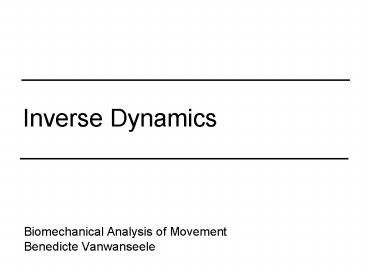Inverse Dynamics PowerPoint PPT Presentation
1 / 25
Title: Inverse Dynamics
1
Inverse Dynamics
- Biomechanical Analysis of Movement
- Benedicte Vanwanseele
2
- Table 3.1 Winter, Biomechanics and motor control
of human movement
3
(No Transcript)
4
Ordering of the Segments
- Start with the terminal segment of a kinematic
chain - The ground reaction forces of the terminal
segment must be known (i.e., measured) or zero
(i.e., free ended) - If not,use the other end of the chain
- If external forces are unknown, measure them,
otherwise, you cannot analyze
5
(No Transcript)
6
Inverse Dynamics LSS
- All forces crossing the ankle are moved to the
ankle joint, thus preserving their translatory
effect - The rotatory effect of these forces is replaced
by a free moment about the ankle
7
Inverse Dynamics LSS
- Once we calculate nett joint forces and torques
at the ankle, these could be used in a free body
diagram of the shank to calculate nett forces and
torques at the knee. - This is the underlying principle of linked
segment dynamics.
8
Inverse Dynamics LSS
- Start calculating forces at the shank
9
Forces acting upon LSS
- Gravitational Forces
- Through the centre of mass.
- Ground Reaction or External Forces
- Considered to act at a point, centre of pressure.
- Muscle and Ligament Forces
- The nett effect of muscle actions muscle
moments - Muscle action will increase nett joint reaction
forces - Bone-on-bone force is the result of muscle action
and joint reaction forces
10
Generic Free Body Diagram
- Td Torque about the distal joint of the segment
- Tp Torque about the proximal joint of the
segment - Fjdx Horizontal component of the distal
joint/muscle force. - Fjdy Vertical component of the distal
joint/muscle force. - Fjpx Horizontal component of the proximal
joint/muscle force. - Fjpy Vertical component of the proximal
joint/muscle force. - wt Weight of the segment.
11
- The 3 equations derived from Newton's second law
can be applied
12
Example
- You have filmed a person running across a force
platform to get ground reaction forces. - From the film you can measure angles,
displacements and accelerations of the segments.
13
Example
- What is the torque exerted at the knee and ankle?
- To do these calculations you need linear and
angular accelerations of each segment vertical
and horizontal distances between the joints and
the centre of mass and the mass and moment of
inertia of each segment. (These must come from
the film or from tables. I will give these to you
as we look at each segment individually)
14
Calculate ankle joint forces
15
Step 1
16
Calculate ankle joint torque
?T Ia
17
Step 1
Ta
?T Ia TGRFy TGRFXTFax Tfax Ta
Ia (1000x0.04) - (200x0.02) (940.6x0.065) -
(140x0.0375) Ta 0.006x100 Ta-91.3Nm
18
Calculate knee joint reaction forces
19
Step 2
20
Calculate knee torque
21
Step 2
- ?T Ia
- TFax TFayTFkx TFky Tk Ta Ia
- -(940.6x0.078) - (140x0.213) - (736.7x0.059) -
(28.4x0.163) Tk 91.3 0.054x (-70) - Tk56.2Nm
22
- What is the torque exerted at the knee and ankle?
- Ankle 91.3 Nm plantar flex moment
- Knee 56.2 Nm extension moment
56.2Nm
91.3 Nm
23
- This process can be continued to the thigh to
calculate forces and torques at the hip. - If this process was continued further to
calculate shoulder torques we would expect
significant errors because the trunk violates the
original assumptions of our model.
24
Calculate hip joint torque
- Mthigh 8.0 kg
- Ithigh 0.209 kgm2
- Lthigh 0.50 m
- ? 50 rad/s2
- ax 20 m/s2
- ax 5 m/s2
- Thigh segment is vertical
- Centre of mass is 0.22 m from proximal end
25
Further Analysis
- To calculate the work and/or rate of work (power)
done by muscles you need to know - Nett joint torque
- Angular displacement of the joint
- Angular velocity of the joint
- Note Joint data i.e. data between two segments

